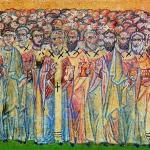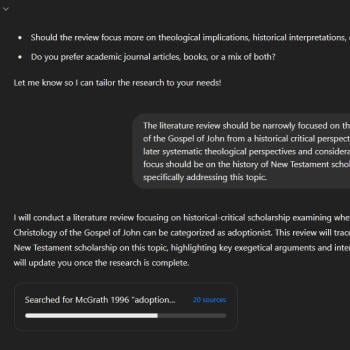My Sunday school class returned to the Gospel of John as part of our discussion of women in the Gospels, looking at the story about the Samaritan woman in John 4. One Sunday we spent clarifying what is likely the case when it comes to her life story, the “everything she ever did” that Jesus showed awareness of. Among other things it was observed how trips to the well were the ancient equivalent of “meeting by the water cooler.” I suggested we call the ancient version “meeting by the cooler water.”
The following Sunday I wanted to return to the story to make sure we dug into the theological content. While in the preceding chapter Nicodemus showed himself to not be up to the conversation with Jesus, the Samaritan woman holds her own. So much so that in the conversation, a lot of expressions and terms come up that it is easy for a modern reader to gloss over, especially if they are familiar with them from use in churches. What do phrases like “living water” and “worship in Spirit and in truth” really signify?
I found my thoughts turning to a book in the Jewish scriptures that I think may have had a profound influence on John the Baptist, whose influence on Jesus is in turn seen here. Worship in Spirit and in truth is not a purely inward matter that closes eyes and ignores surroundings and other people. It is worship that reflects the fact that God as Spirit, as emphasized in the preceding chapter, moves wherever God wills, not being able to be tied to places, peoples, territories, or nations. That is the point of the opening of Ezekiel, in which God’s presence via the celestial ark of the covenant, with wheels that can move without turning in any direction, can be with the exiles in Babylonia, and anywhere else. The vision that concludes the book may be of a celestial rather than earthly temple, from which waters flow that can bring healing and forgiveness everywhere. That may have influenced John’s baptism in living water with its origins up above. That too is a symbol of divine unpredictability. Anyone who has seen video of a wadi in the Holy Land suddenly filling with flowing water may appreciate the point, and how flowing water seemed to be as unpredictable as Spirit/wind, as any living thing might be.
That divine unpredictability was at work as Jesus found his view of salvation as “of the Jews” challenged and expanded as he saw God at work in a Samaritan woman with profound theological insight to share.
It was the intersection of my work on John the Baptist, and my work on the story of the Samaritan woman, that inspired me to write the song I shared here a while back after I made it the conclusion to a sermon about John 4, “Come Where The Healing Waters Flow”:
Before we ended, I was struck by the fact that Zoom was connecting us as the Sunday school met in ways that might be considered a fitting symbol of the way the Spirit and shared faith connect Christians even when separated. This video of Eric Whitacre’s “Sing Gently” conveys that point beautifully. Renowned New Testament scholar Adele Reinhartz is among the singers!













